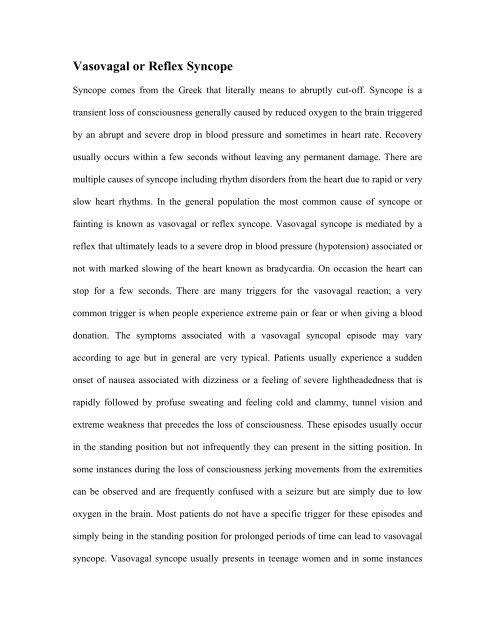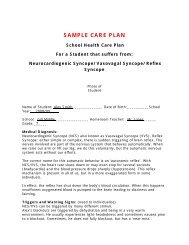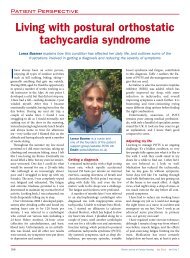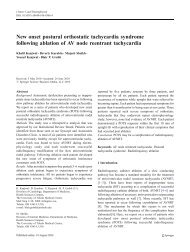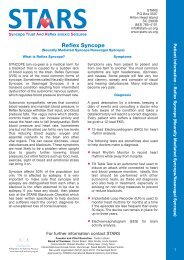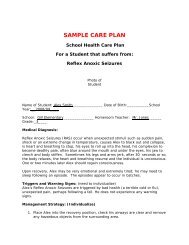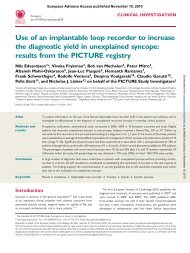Vasovagal or Reflex Syncope - Stars US
Vasovagal or Reflex Syncope - Stars US
Vasovagal or Reflex Syncope - Stars US
Create successful ePaper yourself
Turn your PDF publications into a flip-book with our unique Google optimized e-Paper software.
<strong>Vasovagal</strong> <strong>or</strong> <strong>Reflex</strong> <strong>Syncope</strong><br />
<strong>Syncope</strong> comes from the Greek that literally means to abruptly cut-off. <strong>Syncope</strong> is a<br />
transient loss of consciousness generally caused by reduced oxygen to the brain triggered<br />
by an abrupt and severe drop in blood pressure and sometimes in heart rate. Recovery<br />
usually occurs within a few seconds without leaving any permanent damage. There are<br />
multiple causes of syncope including rhythm dis<strong>or</strong>ders from the heart due to rapid <strong>or</strong> very<br />
slow heart rhythms. In the general population the most common cause of syncope <strong>or</strong><br />
fainting is known as vasovagal <strong>or</strong> reflex syncope. <strong>Vasovagal</strong> syncope is mediated by a<br />
reflex that ultimately leads to a severe drop in blood pressure (hypotension) associated <strong>or</strong><br />
not with marked slowing of the heart known as bradycardia. On occasion the heart can<br />
stop f<strong>or</strong> a few seconds. There are many triggers f<strong>or</strong> the vasovagal reaction; a very<br />
common trigger is when people experience extreme pain <strong>or</strong> fear <strong>or</strong> when giving a blood<br />
donation. The symptoms associated with a vasovagal syncopal episode may vary<br />
acc<strong>or</strong>ding to age but in general are very typical. Patients usually experience a sudden<br />
onset of nausea associated with dizziness <strong>or</strong> a feeling of severe lightheadedness that is<br />
rapidly followed by profuse sweating and feeling cold and clammy, tunnel vision and<br />
extreme weakness that precedes the loss of consciousness. These episodes usually occur<br />
in the standing position but not infrequently they can present in the sitting position. In<br />
some instances during the loss of consciousness jerking movements from the extremities<br />
can be observed and are frequently confused with a seizure but are simply due to low<br />
oxygen in the brain. Most patients do not have a specific trigger f<strong>or</strong> these episodes and<br />
simply being in the standing position f<strong>or</strong> prolonged periods of time can lead to vasovagal<br />
syncope. <strong>Vasovagal</strong> syncope usually presents in teenage women and in some instances
can be certainly disabling due to frequent episodes that occasionally can be associated<br />
with injuries during the falls. Typically these episodes present at the age of 13 – 16 yrs of<br />
age. Women are affected m<strong>or</strong>e frequently and the explanation f<strong>or</strong> this remains debated. A<br />
hist<strong>or</strong>y of fainting usually in the mother is observed in a significant prop<strong>or</strong>tion of subjects<br />
and some investigat<strong>or</strong>s have proposed that some inherited alteration may lead to the<br />
inappropriate reflex responses that leads to vasovagal syncope. Most patients fail to<br />
identify the symptoms that precede the syncopal episode and this prevents them from<br />
ab<strong>or</strong>ting the episodes due to lack of understanding of the symptoms. <strong>Vasovagal</strong> syncope<br />
is not necessarily a disease and is mostly explained by inadequate adaptation of reflex<br />
mechanisms that control heart rate and blood pressure.<br />
How is vasovagal syncope diagnosed?<br />
Usually a detailed hist<strong>or</strong>y is sufficient to make the diagnosis and differentiate between a<br />
seizure dis<strong>or</strong>der and vasovagal syncope. However frequently symptoms may be very<br />
sh<strong>or</strong>t lived and patients tend to fail to identify their premonit<strong>or</strong>y symptoms. The presence<br />
of a trigger such as pain, dehydration, standing f<strong>or</strong> prolonged periods of time associated<br />
with no evidence of any heart disease usually points towards the diagnosis of vasovagal<br />
<strong>or</strong> reflex syncope. <strong>Vasovagal</strong> syncope may be m<strong>or</strong>e challenging to diagnose in older<br />
subjects due to several reasons that include no mem<strong>or</strong>y of the episode, and lack of<br />
premonit<strong>or</strong>y symptoms. When the hist<strong>or</strong>y does not reveal a typical presentation <strong>or</strong> to<br />
confirm the diagnosis of vasovagal syncope a tilt table test may be helpful to establish the<br />
diagnosis. It is imp<strong>or</strong>tant to recognize that a person may have vasovagal syncope and tilt<br />
table may still be n<strong>or</strong>mal in up to 30% of subjects. Tilt table test is a provocative test that<br />
is known to trigger vasovagal responses in a significant prop<strong>or</strong>tion of susceptible subjects.
The test consists of close monit<strong>or</strong>ing of heart rate and blood pressure preferably with<br />
devices that can rec<strong>or</strong>d beat-to-beat blood pressure and heart rate. Typically the subject<br />
has an intravenous line started f<strong>or</strong> fluid infusion. The patient is placed on an<br />
electronically driven table in the supine position f<strong>or</strong> 10 minutes and afterwards placed in<br />
the standing position at an angle between 60 to 80 degrees. The subject is left in the<br />
upright position f<strong>or</strong> anywhere between 15 to 20 minutes. In about half the patients this<br />
maneuver alone will be able to trigger a vasovagal syncope response. In the other half<br />
after the 15-20 minute period in the upright tilt position no abn<strong>or</strong>mal response, which is<br />
mainly to elicit a syncopal episode is observed and certain provocative measures can be<br />
used. In patients under 40 years of age an infusion with Isoproterenol, a drug that mimics<br />
adrenaline, may trigger the vasovagal syncope response. In patients older than 40 years<br />
either sublingual <strong>or</strong> spray nitroglycerine is used to provoke syncope. The test is useful to<br />
determine the susceptibility of patients and is also useful to educate patients about their<br />
premonit<strong>or</strong>y symptoms. Appropriate and rapid identification of these symptoms is of<br />
paramount imp<strong>or</strong>tance to prevent the development of syncope and helps prevent these<br />
episodes.<br />
Is vasovagal syncope dangerous and is there treatment f<strong>or</strong> this condition?<br />
By in large vasovagal syncope is a benign condition in the sense that the people with<br />
vasovagal syncope have the same risks compared to subjects without vasovagal syncope.<br />
None the less in some instances vasovagal syncope can be markedly disabling to the<br />
point that some patients may have a severely impaired quality of life related with frequent<br />
episodes of vasovagal syncope that limit the subjects ability to w<strong>or</strong>k <strong>or</strong> function during<br />
daily activities.
<strong>Vasovagal</strong> syncope can be treated!<br />
The first step is to recognize the premonit<strong>or</strong>y symptoms once this is achieved simple<br />
measures can be recommended. Interestingly most subjects that suffer from frequent<br />
vasovagal syncope have low salt diets. One of the simplest measures is to increase salt<br />
intake simply by adding salt to most meals. Some patients do not tolerate the taste of salt<br />
so in these instances salt pills may be useful. The recommendation of increased salt<br />
intake should always be associated with the recommendation of increasing water intake.<br />
Water intake should be increase to 3 to 4 liters a day. Several studies have shown that<br />
these simple measures help prevent the recurrence of most vasovagal syncope episodes.<br />
Simple maneuvers that are known to increase blood pressure and help returning m<strong>or</strong>e<br />
rapidly the blood that is pooled in the legs back to the heart can be taught to most patients<br />
particularly younger ones. These maneuvers should typically be used immediately after<br />
the first symptoms that precede vasovagal syncope appear. Several maneuvers such as<br />
crossing the legs with contraction of the thighs and gluteus muscles have been<br />
demonstrated in clinical trials to be very effective in preventing and ab<strong>or</strong>ting these<br />
episodes. Similarly, hand grip and squatting may be equally effective. These maneuvers<br />
are not recommended in elderly patients due to the risks of falls. The above<br />
recommendations usually improve the recurrence of vasovagal syncope in most patients.<br />
However there is a group of individuals in which these maneuvers are not useful and<br />
therapy with medications is indicated. A number of compounds with very diverse<br />
mechanisms have been proposed f<strong>or</strong> the management of recurrent vasovagal syncope.<br />
The most commonly used compounds include beta-blockers, fl<strong>or</strong>inef and midodrine. A<br />
detailed discussion on how <strong>or</strong> when to administer these medications is out of the scope of
this communication. Is a pacemaker needed f<strong>or</strong> people with refract<strong>or</strong>y vasovagal<br />
syncope? Initially some studies suggested that in some patients pacemakers were very<br />
effective however m<strong>or</strong>e recent studies failed to demonstrate that pacemakers prevented<br />
the recurrence of vasovagal syncope. In a very small group of patients in which an<br />
extremely slow heart rate associated with pauses greater than 6 seconds directly linked<br />
with the vasovagal syncope a pacemaker may prove to be useful. Several studies are<br />
currently being perf<strong>or</strong>med to answer this question and today pacemakers are rarely used<br />
in patients with vasovagal syncope.<br />
In summary vasovagal syncope is the most common cause of syncope and frequent<br />
fainting spells, usually presents in younger patients with healthy hearts and is<br />
characterized by very typical triggers <strong>or</strong> premonit<strong>or</strong>y symptoms that are easily<br />
recognizable. Older patients may manifest with a m<strong>or</strong>e atypical presentation such as<br />
frequent falls and no mem<strong>or</strong>y of having had a transient loss of consciousness. The<br />
diagnosis can be supp<strong>or</strong>ted by a tilt table test and treatment is usually simple and guided<br />
to promote maneuvers that rest<strong>or</strong>e the reflex responses that control heart ate and blood<br />
pressure particularly in the standing position. Medications are also available and most<br />
patients usually respond well to treatment. It is of paramount imp<strong>or</strong>tance to recognize this<br />
entity as in some instances it is confused with symptoms <strong>or</strong> other causes of syncope that<br />
delay proper treatment. By in large vasovagal syncope is a benign condition but frequent<br />
episodes can markedly impair individual’s quality of life. There are many centers in<br />
N<strong>or</strong>th America that have expertise in diagnosing and managing this condition.
Carlos A M<strong>or</strong>illo, MD, FRCPC, FACC, FHRS, FESC, STARS Board of Trustee. Carole<br />
E. Smith, RN, From the Arrhythmia Service and <strong>Syncope</strong> and Autonomic Dis<strong>or</strong>der Unit<br />
McMaster University, HHSC, Hamilton, Ontario, Canada


